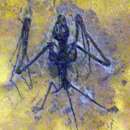en
names in breadcrumbs


Archaeonycteridae (formerly spelled Archaeonycterididae) is a family of extinct bats. It was originally erected by the Swiss naturalist Pierre Revilliod as Archaeonycterididae to hold the genus Archaeonycteris. It was formerly classified under the superfamily Icaronycteroidea (disused) by Kurten and Anderson in 1980. In 2007, the spelling was corrected to Archaeonycteridae and it was reclassified to the unranked clade Microchiropteramorpha by Smith et al..[1][2] The family Palaeochiropterygidae was also merged into Archaeonycteridae by Kurten and Anderson, but modern authorities specializing in bat fossils maintain the distinction between the two.[3][4]
They existed from the Ypresian to the Lutetian ages of the Middle Eocene epoch (55.8 to 40.4 million years ago).[1]
The family is known to closely resemble modern bat species from the well preserved specimens found in the Messel Pit Fossil Site in Germany. Other discoveries were made in Europe and other areas of the Northern Hemisphere that restricted the known distribution range to sites associated with the Laurasian land mass. This range of the family was extended to include a species found in 1990 at the Murgon fossil site on the Australian continent, and they appear to have become globally dispersed during the early Miocene.[5]
It contains four genera. The following list may be incomplete or inaccurate:[1]
Archaeonycteridae (formerly spelled Archaeonycterididae) is a family of extinct bats. It was originally erected by the Swiss naturalist Pierre Revilliod as Archaeonycterididae to hold the genus Archaeonycteris. It was formerly classified under the superfamily Icaronycteroidea (disused) by Kurten and Anderson in 1980. In 2007, the spelling was corrected to Archaeonycteridae and it was reclassified to the unranked clade Microchiropteramorpha by Smith et al.. The family Palaeochiropterygidae was also merged into Archaeonycteridae by Kurten and Anderson, but modern authorities specializing in bat fossils maintain the distinction between the two.
They existed from the Ypresian to the Lutetian ages of the Middle Eocene epoch (55.8 to 40.4 million years ago).
The family is known to closely resemble modern bat species from the well preserved specimens found in the Messel Pit Fossil Site in Germany. Other discoveries were made in Europe and other areas of the Northern Hemisphere that restricted the known distribution range to sites associated with the Laurasian land mass. This range of the family was extended to include a species found in 1990 at the Murgon fossil site on the Australian continent, and they appear to have become globally dispersed during the early Miocene.